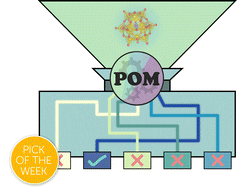Computational insights into aqueous speciation of metal-oxide nanoclusters: an in-depth study of the Keggin phosphomolybdate
Herein, we present a new computational methodology that unlocks the prediction of the complex multi-species multi-equilibria processes involved in the formation of complex metal-oxo nanoclusters. Relying on our recently introduced method named POMSimulator, we extended its capabilities and challenged its accuracy with the well-known phosphomolybdate [PMo12O40]3- Keggin anion system. We show how the use of statistical techniques enabled the processing of a vast number of speciation models and their associated systems of non-linear equations efficiently and in a scalable manner. Subsequently, this approach is applied to generate statistically averaged speciation diagrams and their associated error bars. Then, we unveil the previously unreported speciation phase diagram under varying [Mo]/[P] ratios vs. pH. Our findings align well with experimental data, indicating the prevalence of the Keggin {PMo12} as the primary species at low pH, but the lacunary {PMo11}and Strandberg {P2Mo5} anions also emerge as major species at other concentration ratios. Finally, from 7 x 104 speciation models we inferred a plausible reaction network across the diverse nuclearities present within the system, which underlines the role of trimers as key intermediate building blocks. Herein, we present a new computational methodology that unlocks the prediction of the complex multi-species multi-equilibria processes involved in the formation of complex metal-oxo nanoclusters.

Buils, J.; Garay-Ruiz, D.; Segado-Centellas, M.; Petrus, E.; Bo, C.
Chem. Sci. 2024
DOI:
10.1039/d4sc03282a

Let's create a brighter future
Join our team to work with renowned researchers, tackle groundbreaking
projects and contribute to meaningful scientific advancements




















